Astronomical Seasons and Illumination
Astronomical seasons are based on the orientation of Earth’s axis of rotation to the Sun, which determines the amount of illumination between the Northern and Southern Hemispheres. A solstice occurs when the Earth’s axis of rotation tilts toward the Sun, causing one hemisphere to be at peak illumination and the other to be minimally illuminated. An equinox occurs when both hemispheres are equally illuminated since neither end of the axis of rotation is pointed toward the Sun.
In the following animations, the spatial and time scales are not realistic(!), but they are intended to illustrate that the Earth’s axis of rotation (red line) remains fixed in space as it orbits the Sun (yellow). The orbital plane is shown in green, and the line through the center of the Earth that remains perpendicular to the orbital plane is cyan (blue-green).
At any given time, half the Earth is illuminated, and half is in shadow. During the orbit, notice when the northern part of the axis of rotation is always illuminated or always in shadow. For reference for illumination patterns that occur at other latitudes, 40ºN is drawn in orange.
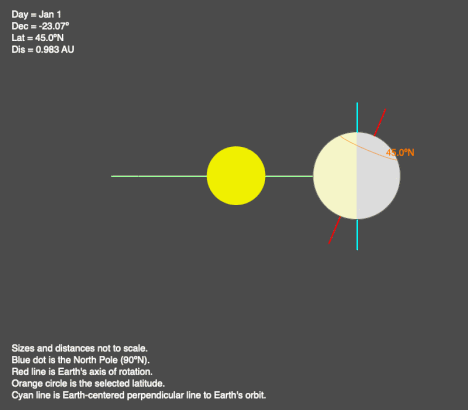
Viewing Earth’s orbit around the Sun from the side helps illustrate how the axis of rotation remains fixed.
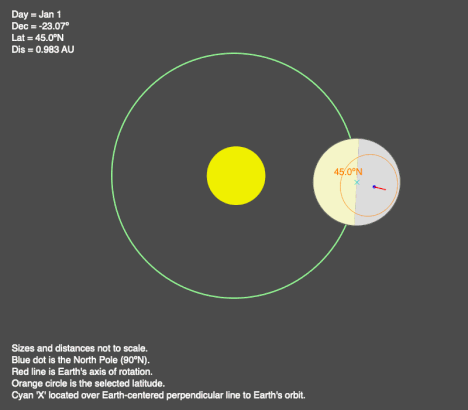
Viewing the Earth’s orbit around the Sun from above illustrates how the polar latitudes go from extended periods of sunlight to extended periods of darkness.
Solstices and Equinoxes
Since the Earth makes 365.256 revolutions during its orbit around the Sun, our calendar of the seasons is not constant. Nearly every four years we have a leap year to bring our calendar back in alignment with Earth’s position in its orbit. The following dates of the solstices and equinoxes, which mark the beginning of our seasons, are ± one day.
Calculating Hours of Daylight
In the “Illuminated Earth at Local Noon” images below, use the longitude lines to calculate the amount of sunlight for a particular latitude. The longitude lines are 15º apart, which represents an hour. Each illuminated 15º arc of longitude represents 2 hours of sunlight (the same illumination pattern occurs on the other half of the Earth that you aren’t viewing). Follow a line of latitude to calculate the duration of daylight for that location.
December 21 Solstice
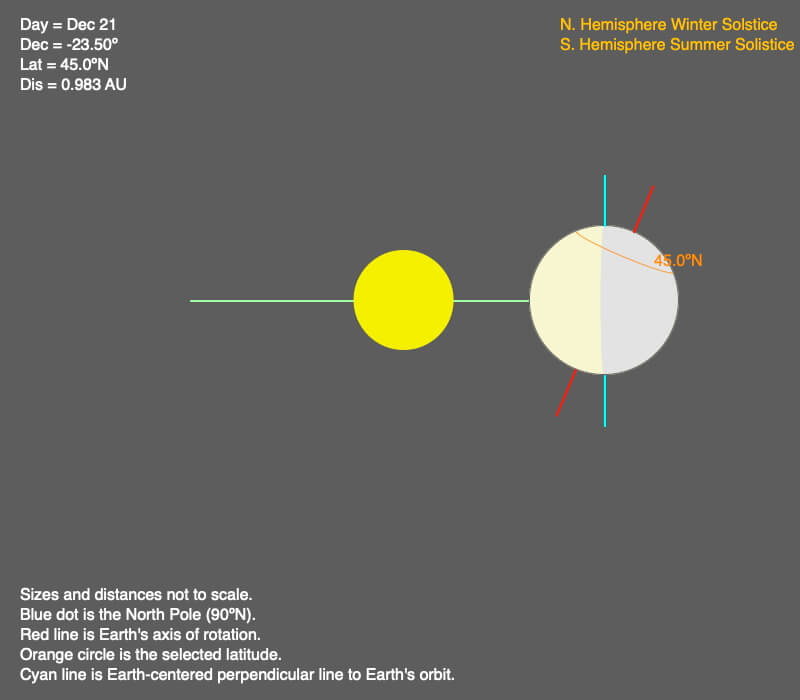
The Earth’s axis of rotation in the Southern Hemisphere points most toward the Sun on December 21 so this is the summer solstice for the Southern Hemisphere the winter solstice for the Northern.
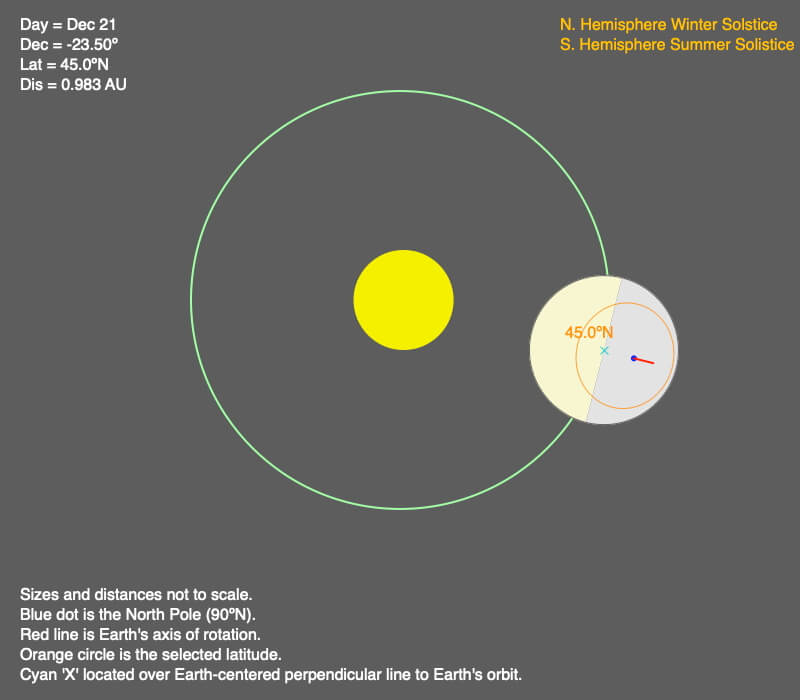
On December 21, the Southern Hemisphere is most illuminated compared to the Northern, and this marks the beginning of summer in the southern latitudes and winter in the north.
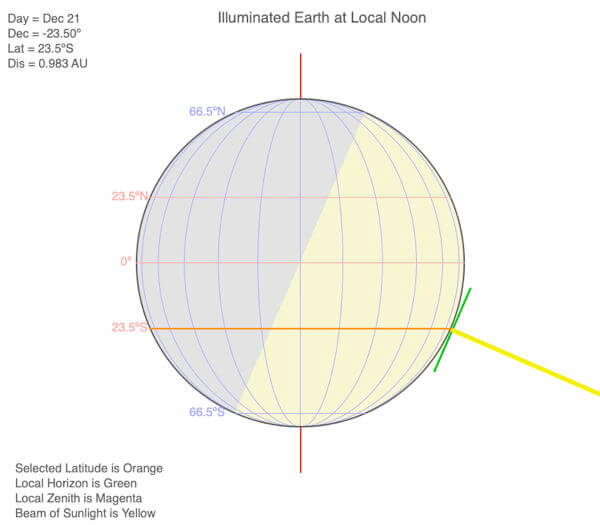
The Sun is directly overhead 23.5ºS at local noon on December 21. Local noon is when the Sun is highest in the sky (see Earth’s Coordinate System).
How many hours of daylight would a person experience at the 90ºN, 23.5ºN, 0º, 23.5ºS, and 90ºS?
On December 21, a person at the North Pole (90ºN) experiences 0 hours of sunlight, but at the South Pole (90ºS), there are 24 hours of sunlight that day.
At the Tropic of Cancer (23.5ºN), there are roughly 5 and a quarter longitude segments illuminated, so there are 10.5 hours of sunlight that day. The reverse occurs at the Tropic of Capricon (23.5ºS), there are 5 and a quarter shaded longitude segments, so there are 10.5 hours of darkness and 13.5 hours of sunlight.
At the Equator (0º), there are 12 hours of sunlight.
March 21 Equinox
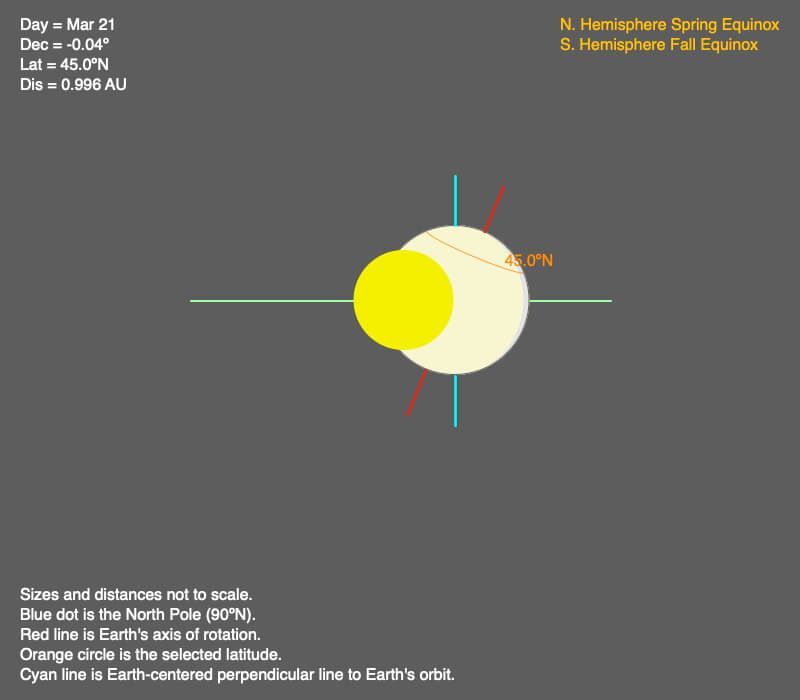
The Earth’s axis of rotation points neither toward or away from the Sun on March 21, so this is an equinox.
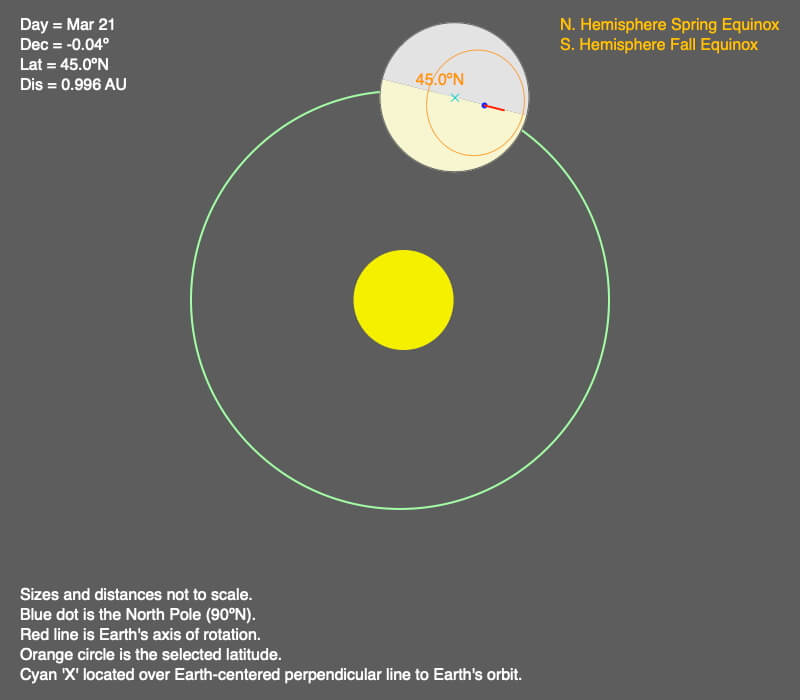
Both hemispheres are evenly illuminated during an equinox. The Southern Hemisphere is leaving summer, so this is their fall equinox. For the northern latitudes, this is the spring equinox.
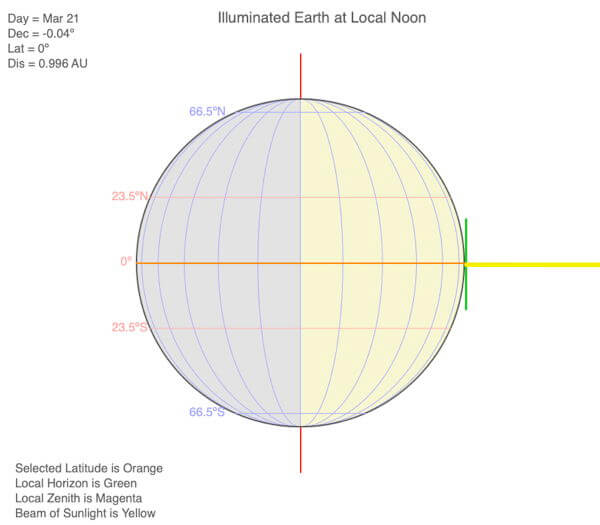
The Sun is directly overhead the Equator (0º) at local noon on March 21.
How many hours of daylight would a person experience at the 90ºN, 23.5ºN, 0º, 23.5ºS, and 90ºS?
During an equinox, everyone except those living at the Poles experiences 12 hours of sunlight. At the North and South Poles, the Sun remains on the horizon all day.
June 21 Solstice
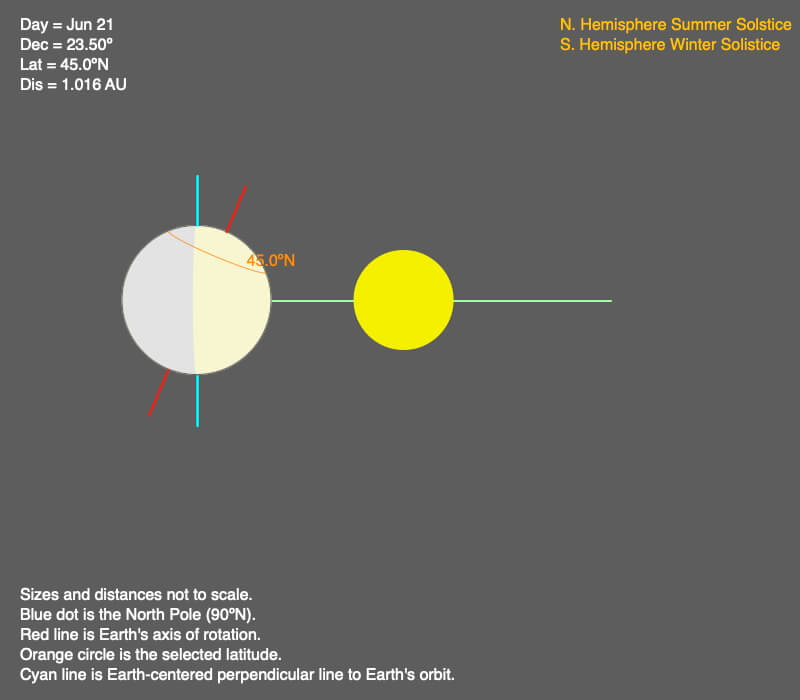
The Earth’s axis of rotation points toward the Sun on June 21 so this is a solstice.
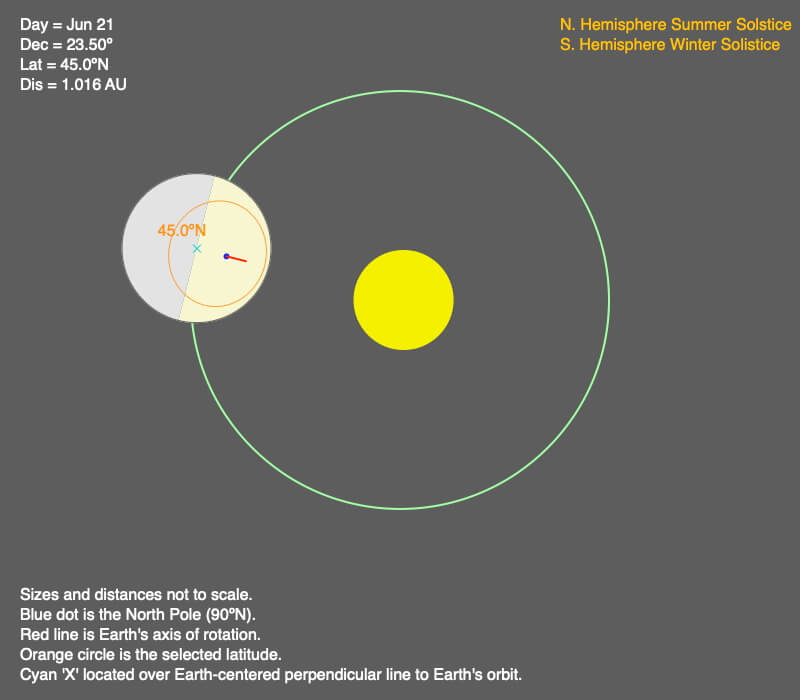
Since the Northern Hemisphere is more illuminated than the Southern, this is the beginning of summer in the northern latitudes and winter in the south.
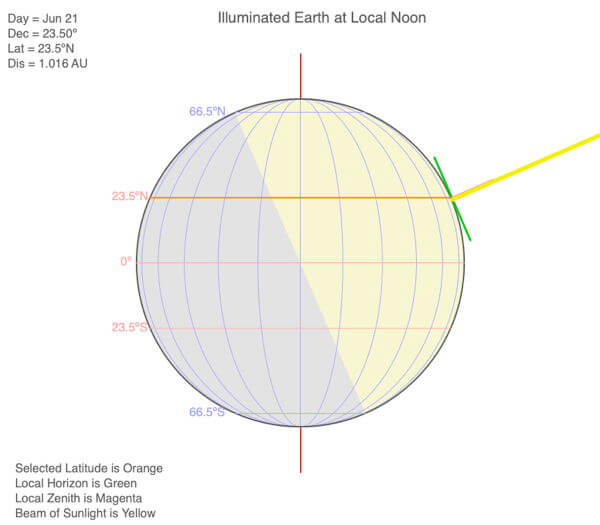
The Sun is directly overhead 23.5ºN at local noon on June 21.
How many hours of daylight would a person experience at the 90ºN, 23.5ºN, 0º, 23.5ºS, and 90ºS?
The hours of sunlight are opposite for those observed during the December 21 solstice.
On June 21, a person at the North Pole (90ºN) experiences 24 hours of sunlight, but at the South Pole (90ºS), there are 24 hours of darkness.
At the Tropic of Cancer (23.5ºN), there are roughly 5 and a quarter shaded longitude segments, so there are 10.5 hours of darkness and 13.5 hours of sunlight that day. The reverse occurs at the Tropic of Capricon (23.5ºS), there are 5 and a quarter illuminated longitude segments, so there are 10.5 hours of sunlight.
At the Equator (0º), there are 12 hours of sunlight.
September 22 Equinox
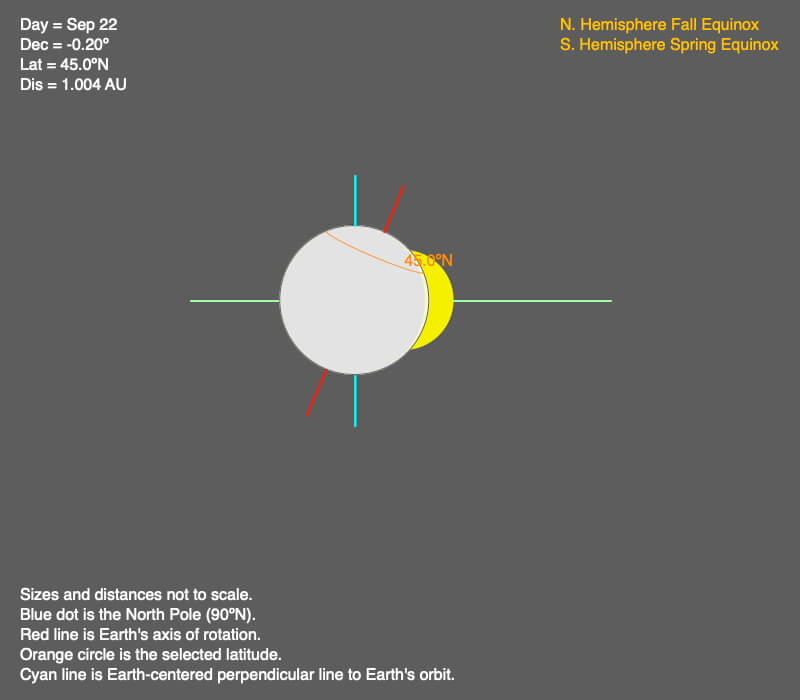
The Earth’s axis of rotation points neither toward or away from the Sun on September 22, so this is an equinox.
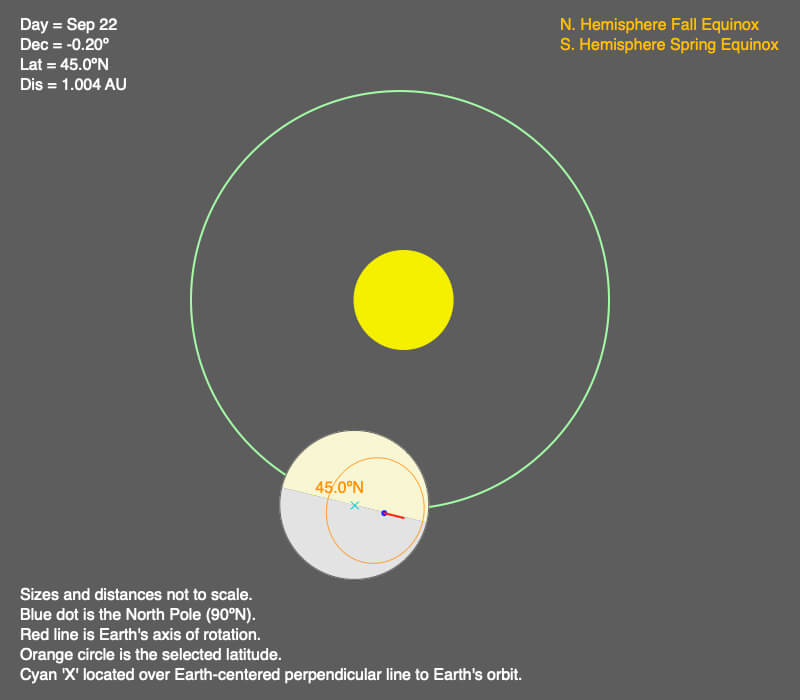
Both hemispheres are evenly illuminated during an equinox. The Southern Hemisphere is leaving winter, so this is their spring equinox. For the northern latitudes, this is the fall equinox.
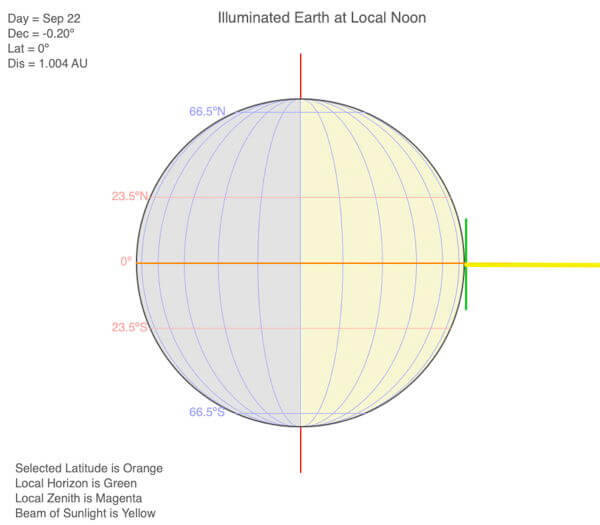
The Sun is directly overhead the Equator (0º) at local noon on September 22.
How many hours of daylight would a person experience at the 90ºN, 23.5ºN, 0º, 23.5ºS, and 90ºS?
During an equinox, everyone except those living at the Poles experiences 12 hours of sunlight. At the North and South Poles, the Sun remains on the horizon all day.
Challenge Questions
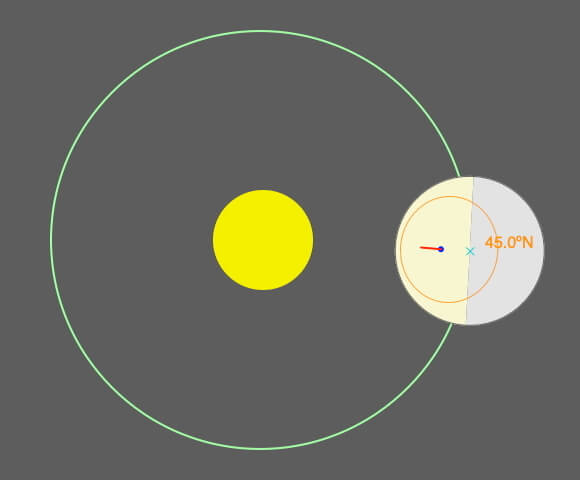
Is Earth close to an equinox or a solstice? If a solstice, which hemisphere is near the beginning of summer?
The North Pole is pointing in the direction of the Sun. More of the Northern Hemisphere is being illuminated, so it is close to the June 21 solstice.
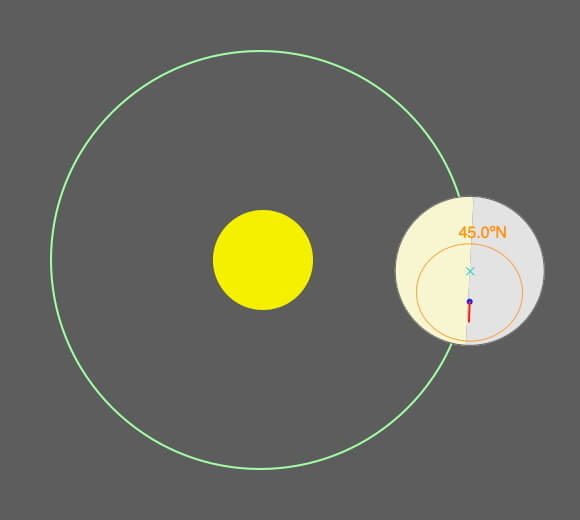
Is Earth close to an equinox or a solstice? If a solstice, which hemisphere is near the beginning of summer?
The Earth’s shadow is nearly over the North Pole, so both hemispheres are almost evenly illuminated. This day is close to an equinox.
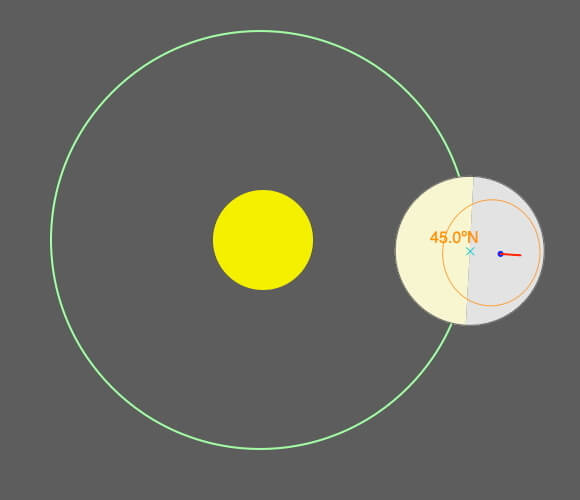
Is Earth close to an equinox or a solstice? If a solstice, which hemisphere is near the beginning of summer?
The North Pole is pointing away from the Sun. More of the Southern Hemisphere is being illuminated, so it is close to the December 21 solstice.
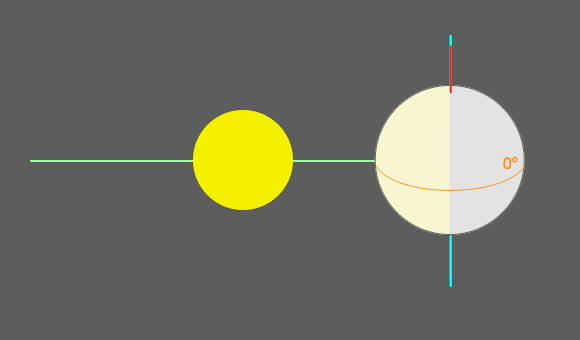
Is Earth close to an equinox or a solstice? If a solstice, which hemisphere is near the beginning of summer?
The Earth’s shadow is nearly over the North Pole, so both hemispheres are almost evenly illuminated. This day is close to an equinox.
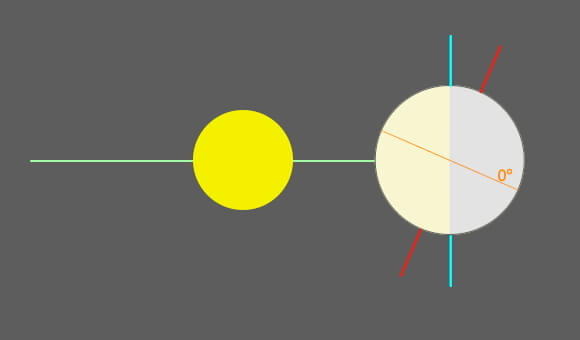
Is Earth close to an equinox or a solstice? If a solstice, which hemisphere is near the beginning of summer?
The North Pole is pointing away from the Sun. More of the Southern Hemisphere is being illuminated, so it is close to the December 21 solstice.
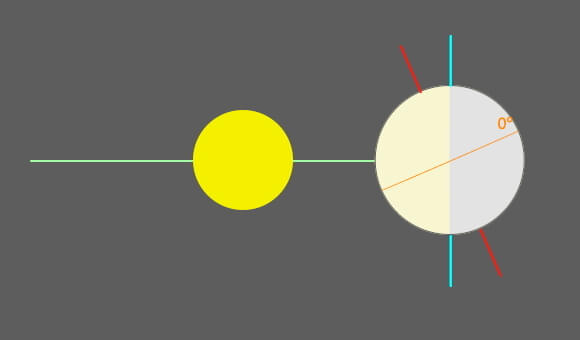
Is Earth close to an equinox or a solstice? If a solstice, which hemisphere is near the beginning of summer?
The North Pole is pointing in the direction of the Sun. More of the Northern Hemisphere is being illuminated, so it is close to the June 21 solstice.
Continue Exploring Earth’s Orbit Around the Sun
Use the desktop app, Sun-Earth Connection, to explore the Earth’s illumination at any day during its orbit. Download Mac or PC versions at the Software page.
Big Ideas
- Obliquity is the angle between the planes of the Earth’s equator and its orbit around the Sun. Another way to think about it is the angle of the Earth’s axis of rotation from the perpendicular to the plane of orbit. Earth’s obliquity is 23.5º.
- Earth’s obliquity creates seasonal cycles of uneven heating between the Northern Hemisphere and the Southern Hemisphere
Click on the following toggles to view descriptions and links of the web pages on each topic of the Sun-Earth Connection.
Sun-Earth Connection overview
An overview of how the Sun’s energy is generated and how its thermal radiation illuminates and heats Earth.
Earth Illumination Patterns
- Overview: The Sun illuminates the spherical, rotating planets orbiting it.
- Obliquity and Earth’s Illumination: Obliquity is the angle between the planes of the Earth’s equator and its orbit around the Sun.
- Declination, Latitude, & Earth Illumination: Solar declination is the angle between the Sun’s rays and the plane of the Earth’s Equator. Its value depends on where Earth is in its orbit around the Sun.
- Astronomical Seasons & Illumination: Astronomical seasons are based on the orientation of Earth’s axis of rotation to the Sun, which determines the amount of illumination between the Northern and Southern Hemispheres.
Distribution of the Sun's Energy on Earth
- Overview: Even though an area is illuminated by sunlight, there can be quite a range of energy interacting with the surface.
- Sun Angle and Beam Concentration: If every beam of sunlight reaching Earth has the same amount of energy, why do some areas warm up more than others?
- Diurnal Heating: Diurnal heating is the temperature change over 24 hours. When sunlight shines on the ground, it warms. Two critical factors that determine the amount of heating deal with the Sun’s illumination.
- Seasons: Earth experiences astronomical seasons due to its obliquity.
- Climate Regimes: Climate regimes are an extension of diurnal heating and seasons, but the time frame is now years.
Declination Circles: A tool to analyze the Sun's position in the sky.
- Overview: Drawings of declination circles contain the visual and numerical information to understand and predict the Sun’s motion across the sky.
- Declination Circles 101: Draw a declination circle with just a ruler and protractor/compass to quickly and accurately know the Sun’s position in the sky at any day and time of the year for any location on Earth.
- Drawing Declination Circles: Declination circles are quite easy to draw by hand.
- Interpreting Time on Declination Circles: Accurately estimate the time of day using the Sun’s location in the sky.
- Sunrise, Sunset, & Twilight: Calculate the timing and duration when the Sun is at or near the horizon.
- Solar Time, Angle, & Position: The sun’s angle and direction to the local horizon define the Sun’s position in the local sky. Explore how to use declination circles to calculate the Sun’s position at any solar time anywhere in the world on any day of the year.
- Changing Views of Declination Circles: Use the web app View Declination Circles to explore three common views of declination circles to identify their strengths, limitations, and applications. Then learn how to go from one view to another.
- Using Declination Circles: Humans have been using the apparent motion of the Sun as a compass, clock, and calendar for millennia.
- Using Sundials: Humans have been using the Sun’s position to navigate and tell the time, day, and season for millennia. Sundials create shadows that make it easier to do these tasks.

0 Comments